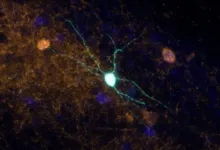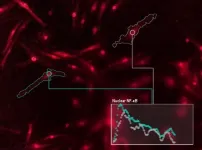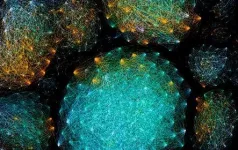Sometimes referred to as the "executive brain", the prefrontal cortex is the region that governs higher-level cognitive functions and decision making. Studies of tissue from this brain region in patients with schizophrenia have detected alterations in two proteins: BDNF (brain-derived neurotrophic factor) and trkB (tyrosine receptor kinase B).
The relationship between BDNF and trkB is important during brain development. When these proteins bind to each other, they trigger a cascade of intracellular signals that are essential to neuronal maturation and growth. Imbalances in this kind of signaling may be associated with the manifestation of certain disorders.
A group of researchers affiliated with the Federal University of Minas Gerais (UFMG) and the University of São Paulo's Ribeirão Preto Medical School (FMRP-USP) in Brazil, and with Sweden's Karolinska Institute, have created a virus capable of carrying the genetic code for a mutant form of trkB. When the modified trkB binds to BDNF, the intracellular signaling cascade is blocked, reproducing characteristics observed in brain tissue from schizophrenia patients.
The research, conducted with funding from FAPESP and the Ministry of Education's Coordination for the Improvement of Higher Education Personel (CAPES), involved parvalbumin-expressing inhibitory interneurons, or PV interneurons for short. Interneurons connect spinal motor and sensory neurons, and can also communicate with each other, forming circuits of various complexity. Firing at relatively high frequencies in the gamma range (30-80 Hertz), they resemble the conductor of an orchestra, regulating excitation and inhibition in the central nervous system.
PV is a protein that plays a role in many processes, such as cell-cycle regulation and muscle contraction, among others. PV interneurons are the most common interneurons in the cortex, and are involved in attention, social memory, and more. Dysfunction of PV interneurons disrupting cortical information processing and cognitive behavior has been detected in psychiatric patients.
The neurons and interneurons in the human brain communicate via electrical and chemical signals to activate or inhibit nearby neurons as well as circuits in distant brain regions. The organized activity of these different circuits gives rise to consciousness, feelings and behavior.
"Using a novel viral strategy for cell-type-specific and spatially restricted expression of a dominant-negative trkB (trkB.DN), we show that BDNF/trkB signaling is essential to the integrity and maintenance of prefrontal PV interneurons in adult male and female mice," the researchers write in an article published in February in the Journal of Neuroscience.
In the study, the genetically modified virus was introduced into the brain tissue of adult transgenic mice using Cre-Lox recombination, a site-specific recombinase technology for inserting or deleting target DNA sequences. The researchers then recorded electrical activity in the prefrontal cortex and found alterations in the excitation-inhibition balance, as well as changes in brain waves and neuronal activity resulting in more aggressive behavior and anxiety.
Specific circuits in the cortex were manipulated in an innovative manner using the technique, explained Cleiton Lopes Aguiar, a professor at UFMG's Institute of Biological Sciences and co-principal investigator for the study alongside Marie Carlén, a professor at Karolinska Institute.
"The results show that manipulating BDNF/trkB in adults can alter not only brain activity but also complex behaviors that depend on the prefrontal cortex," Aguiar said. "It can be inferred that BDNF/trkB signaling is necessary to development, and to maintain mature neural networks."
According to Leonardo Rakauskas Zacharias, a co-author of the article and a researcher at FMRP-USP's Epilepsy Research Laboratory, the new technique enhances the study of the developed adult brain.
The role of interneurons
In the same issue of the Journal of Neuroscience, the group published another article on synchronous activity of cortical inhibitory interneurons expressing parvalbumin. "Brain oscillations are fundamental to the coordination of neuronal activity across neurons and structures. Gamma oscillations (30-80 Hz) have received particular attention through their association with perceptual and cognitive processes. (...) [Here we] show how deficient PV inhibition can lead to increased and asynchronous excitatory firing, contaminating the local field potential and manifesting as increased gamma power. Thus, increased gamma power does not always reflect a genuine rhythm. Further, we show that ketamine-induced gamma increases are caused by separate network mechanisms," the authors explain.
According to Nicolas Gustavo Guyon, a member of the group and a researcher at Karolinska Institute, their analysis of brain oscillations in genetically modified mice detected asynchronous activity due to the inability of PV interneurons to respond to all excitatory stimuli generated by other neurons.
For Aguiar, what both articles have in common is the search for a deeper understanding of the role played by interneurons in the prefrontal cortex and how the brain organizes the excitation-inhibition balance. "We're exploring the normal brain in order to achieve a deeper understanding of psychiatric disorders such as schizophrenia," he said. "We show that if there are alterations in certain specific aspects of these normal animals, they display symptoms that could be initial clues to the mechanisms underlying the disorders."
According to the Pan American Health Organization (PAHO-WHO), mental illness accounts for more than a third of total disability in the Americas, yet investment in mental health programs falls well short of what is required to address the needs of psychiatric patients. The term covers mental disorders such as dementia and schizophrenia, as well as depression. Over 300 million people live with depression, 60 million with bipolar disorders, and 23 million with schizophrenia-related disorders (including 1.5 million Brazilians), the WHO estimates.
Zacharias points out that the group's research projects have been in progress for more than seven years and their results could contribute to the development of potential treatments. "We work with basic science to understand the mechanisms of the brain, and our findings can help all those concerned understand psychiatric disorders a little better," he said.
INFORMATION:
About São Paulo Research Foundation (FAPESP)
The São Paulo Research Foundation (FAPESP) is a public institution with the mission of supporting scientific research in all fields of knowledge by awarding scholarships, fellowships and grants to investigators linked with higher education and research institutions in the State of São Paulo, Brazil. FAPESP is aware that the very best research can only be done by working with the best researchers internationally. Therefore, it has established partnerships with funding agencies, higher education, private companies, and research organizations in other countries known for the quality of their research and has been encouraging scientists funded by its grants to further develop their international collaboration. You can learn more about FAPESP at http://www.fapesp.br/en and visit FAPESP news agency at http://www.agencia.fapesp.br/en to keep updated with the latest scientific breakthroughs FAPESP helps achieve through its many programs, awards and research centers. You may also subscribe to FAPESP news agency at http://agencia.fapesp.br/subscribe.


